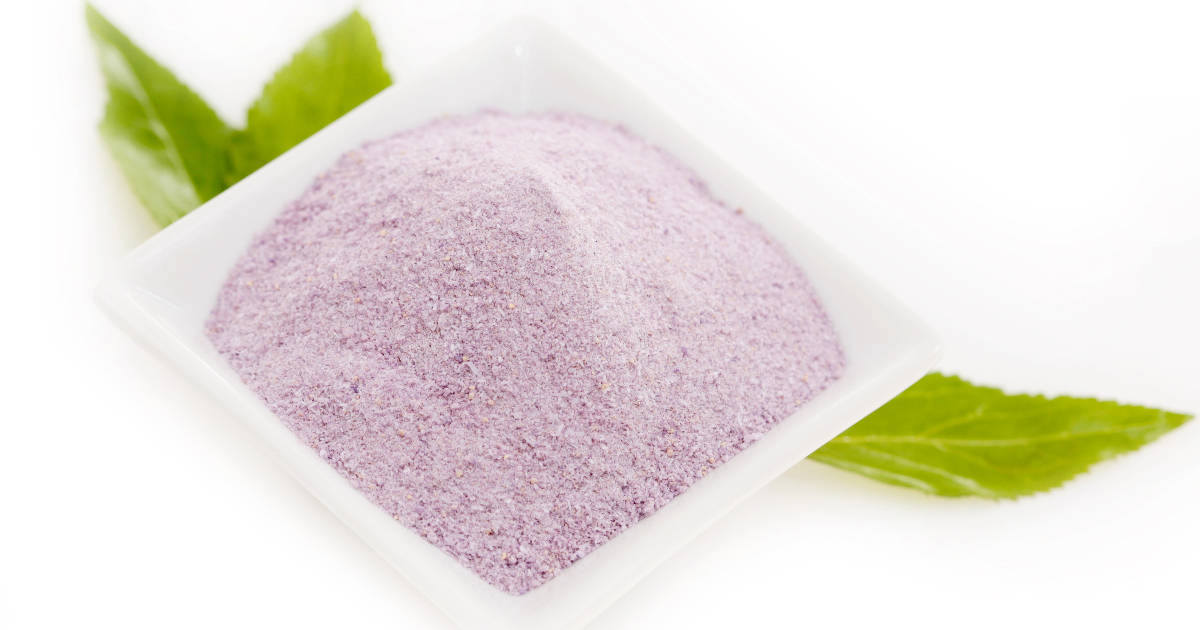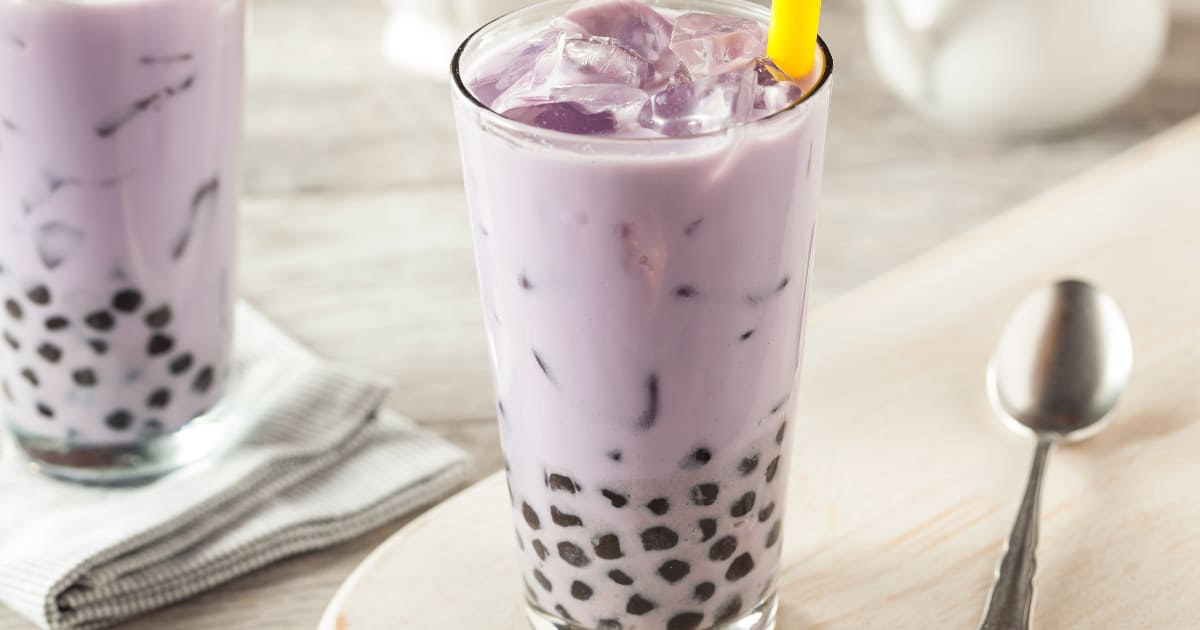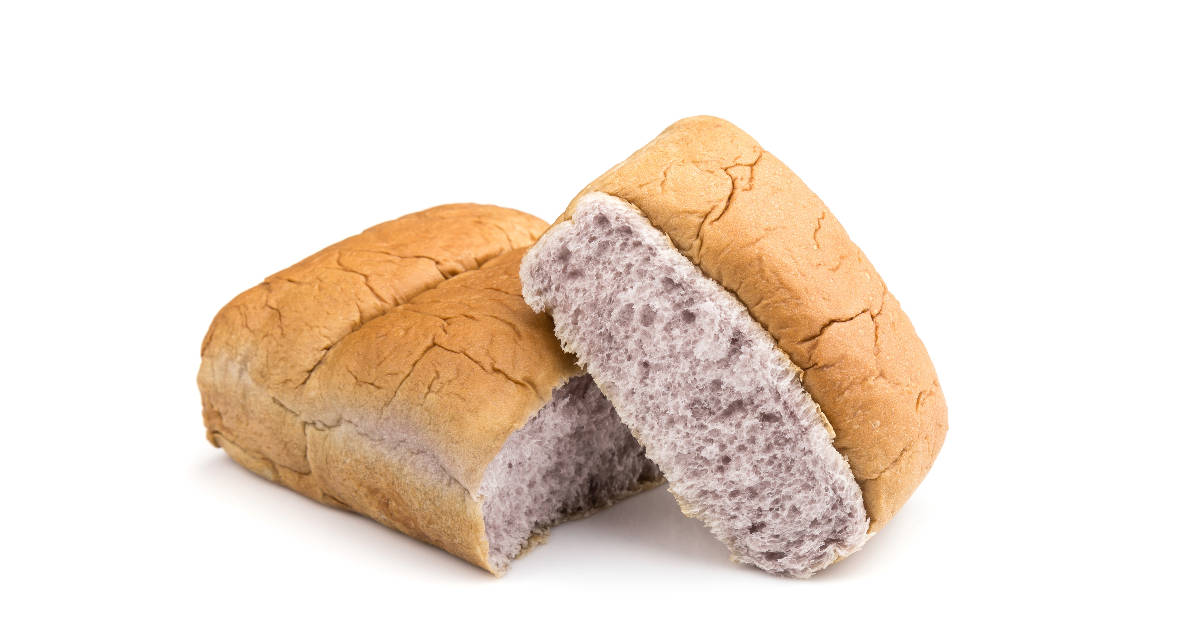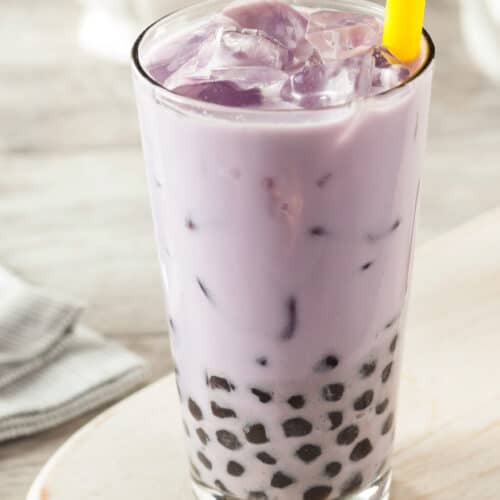Taro powder is a versatile ingredient that can be used in both savory and sweet dishes. This fine purple powder is made from taro root, which is a starchy tuber vegetable that has a slightly sweet, nutty flavor.

Taro powder can provide a pop of color and delicious flavor to many recipes. Read on to learn everything you need to know about working with taro powder in your cooking and baking.
What is Taro Powder?
Taro powder is made by cooking fresh taro root, drying it out, and then grinding it into a fine powder. The powder typically has a light purple hue. When added to liquids, it dissolves and thickens them while also imparting its signature flavor. Taro powder often contains anti-caking agents to prevent clumping. Some brands also add sugar, salt, and dairy creamer products, so check the ingredients list.
Unlike cornstarch or other thickeners, taro powder provides more than just thickness. It also gives recipes a sweetness reminiscent of vanilla and a smooth, creamy mouthfeel. The earthy, nutty notes are more pronounced in powder made directly from taro root versus ones with added flavors.
Buying Taro Powder
When purchasing taro powder, you can typically find it in the Asian section of grocery stores or online. Here are some tips for choosing a high-quality powder:
- Check the ingredients list and choose a pure taro powder without additives like dairy, sugar, or preservatives if you want to control the flavor profile.
- Look for ones made from taro root rather than synthetic flavorings which won't provide the same flavor.
- See if it's produced in Taiwan, as they are known for quality taro powder production.
- Consider organic or non-GMO options if you want to avoid pesticides.
- Examine the color and aroma. Good taro powder should be light purple and smell sweet.
- Check customer reviews to help select a reliably smooth, non-gritty powder.
When stored properly in an airtight container away from moisture and heat, taro powder will keep for up to 1 year.
Using Taro Powder in Drinks

One of the most popular uses for taro powder is making taro bubble tea, also known as taro milk tea. The powder dissolves into the tea and milk base, lending its color, thickness, sweetness, and creamy mouthfeel. Here are a few tips for using taro powder in drinks:
- Start with 1-2 tablespoons of taro powder per 8-12 oz serving. Adjust to taste.
- For thicker drinks, use up to 3-4 tablespoons per serving.
- Whisk the powder into hot water or milk first until smooth, then add ice and other ingredients. This prevents clumping.
- Add taro powder to coffee drinks for a sweet, indulgent twist. It pairs well with espresso.
- Include taro powder in fruit smoothies. Its flavor complements tropical fruits and berries.
- Use it in milkshakes for thickness and sweetness without overpowering the other flavors.
- Mix taro powder into cocktails like margaritas for a fun color and light sweetness.
With its vivid purple shade and sweet vanilla-like taste, taro powder is ideal for making fun, flavorful beverages.
Making Desserts with Taro Powder

Beyond drinks, taro powder can add its signature color, texture, and flavor to all kinds of desserts. Here are some ways to incorporate it:
- Add a few tablespoons of taro powder to cake, brownie, or cookie batter for moistness.
- Whip taro powder into frosting or buttercream for pretty purple colors.
- Make pastel taro-swirled ice cream by blending powder into your base.
- Fold taro powder into mochi dough for a chewy texture and pastel color.
- Add powder to pudding or mousse recipes for flavor and color.
- Use taro powder in homemade Pop-Tarts for a fun twist.
- Make vibrant taro-flavored macarons using powder in the shell and filling.
- Add taro powder to crepes along with sweet fruits or chocolate spreads.
- Swirl taro powder into soft serve for a light, sweet flavor and striking purple hue.
With its mild sweetness, taro powder pairs particularly well with fruit, chocolate, coconut, and vanilla. Get creative with this colorful powder in all kinds of homemade desserts.
Cooking Savory Dishes with Taro Powder
While taro powder is commonly used in desserts and drinks, its versatility also shines in savory dishes. Here are some ideas for using it:
- Make vibrant purple gnocchi by mixing taro powder into the dough. Boil and top with sage butter.
- Add taro powder to bread or pizza dough for color and extra moisture.
- Toss blanched vegetables in taro powder mixed with olive oil and herbs. Roast for a glaze.
- Use as a thickener for curries, stews, chilies, and gravies.
- Mix taro powder into ground meat like chicken, pork, or beef for moisture and flavor.
- Add to dumpling fillings for extra sweetness and a pretty purple hue.
- Make pastel potato pancakes by mixing taro powder into the shredded potato.
- Coat fish or proteins with taro powder before pan-searing for sweetness and caramelization.
- Swap half the flour for taro powder in recipes for baked goods like biscuits.
With a bit of creativity, taro powder can be used to add taste, texture, and visual appeal to all kinds of savory dishes.
Tips for Cooking with Taro Powder
To get the most out of this purple powder, follow these simple tips:
- Start with a small amount like 1-2 tsp and add more to reach the desired flavor and thickness.
- Mix taro powder with hot liquids first to fully dissolve it and prevent lumps.
- When used in breading or coatings, combine taro powder with flour and spices first before coating foods.
- Store unused taro powder in an airtight container in a cool, dry place.
- Opened taro powder will last about 1 year. Unopened can be kept for up to 1.5-2 years.
- If clumps form, sift the powder through a fine mesh strainer before using.
- Substitute up to 1/4 of the flour in baked goods recipes with taro powder.
With its eye-catching color and sweet, nutty taste, taro powder is a unique ingredient that can elevate both sweet and savory recipes. Follow these tips to seamlessly incorporate them into your cooking and baking.
FAQ
What is the difference between taro and ube powder?
Taro and ube powders come from different root vegetables and have some key differences:
- Taro has a brown exterior and mostly white interior with purple flecks. Ube is vibrant purple throughout.
- Taro has an earthy, vanilla-like flavor. Ube tastes more like a red bean with hints of chocolate.
- Taro powder creates a light purple color. The ube powder makes a darker, richer purple.
So in short, taro powder offers a more subtle nutty sweetness and pastel hue compared to the bolder ube.
Can you use taro powder to make fresh taro paste?
Yes, it's possible to make fresh taro paste from taro powder. Here is one method:
- For every 1 cup of taro powder, mix with 1/4 cup of water.
- Bring 1 cup of water to a simmer and slowly whisk in the taro powder mixture.
- Cook for 2-3 minutes, stirring constantly, until thickened to a smooth paste.
- Let the taro paste cool completely before using it in recipes.
The paste won't have the exact same texture as fresh taro but provides a shortcut version with the same great taro flavor.
What recipes use taro powder?
Some popular sweet recipes using taro powder include:
- Taro milk tea or taro bubble tea
- Taro macarons
- Taro ice cream
- Taro mochi
- Taro pudding
- Taro pancakes
Some savory recipes that use taro powder are:
- Taro gnocchi
- Taro dumplings
- Taro-crusted fish or chicken
- Taro flatbread
- Taro curry or stew thickener
- Taro coatings for frying
Can you substitute potato starch for taro powder?
Potato starch can be substituted for taro powder, but keep in mind that it will not provide the same sweet flavor or purple color. The texture will be similar, though potato starch thickens more than taro powder.
Replace taro powder with an equal amount of potato starch. But because potato starch thickens more aggressively, start with 3/4 the amount and adjust as needed.

Taro Bubble Tea Recipe
Ingredients
- 1/4 cup cooked tapioca pearls
- 2 tbsp taro powder
- 1/2 cup milk of choice
- 1/2 cup strong brewed black tea, chilled
- 1 tbsp honey or sugar (optional)
- Ice
Instructions
- In a tall glass, add tapioca pearls.
- In a blender, combine taro powder, milk, sweetener if using, and chilled tea. Blend until smooth.
- Pour taro milk tea over tapioca pearls. Add ice and enjoy with a bubble tea straw!
Conclusion
With its versatility to add nutrition, flavor, color, and thickness to recipes both sweet and savory, taro powder is a unique ingredient worth exploring in your cooking.
From beverages to baked goods to all kinds of dishes, this purple powder can elevate recipes beyond basic flour or starch. Taro powder is simple to use. Just remember to fully dissolve it, adjust the amount to suit your needs, and store it properly.
With a bag of taro powder in your pantry, you can easily give recipes a flavorful twist.

